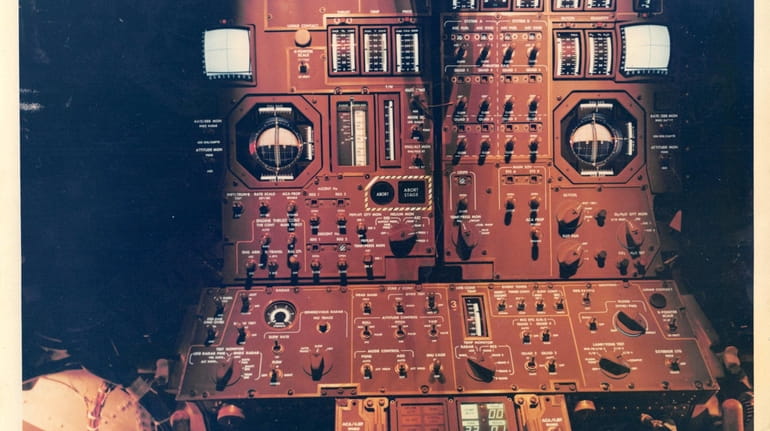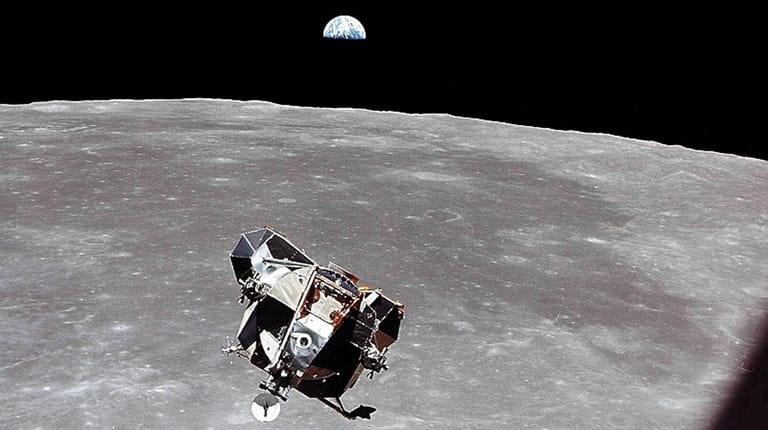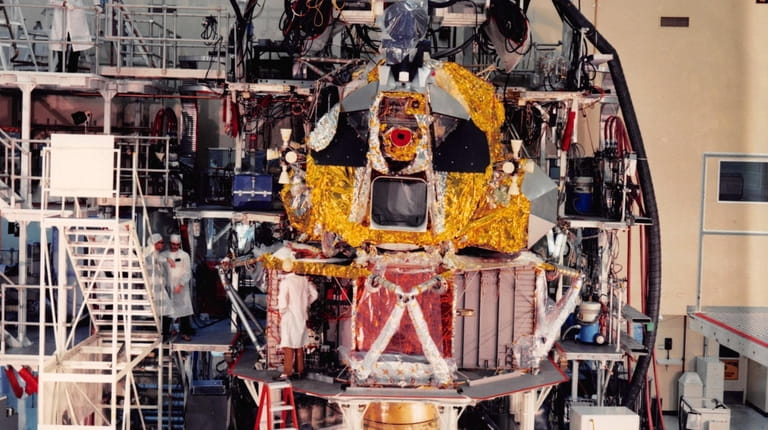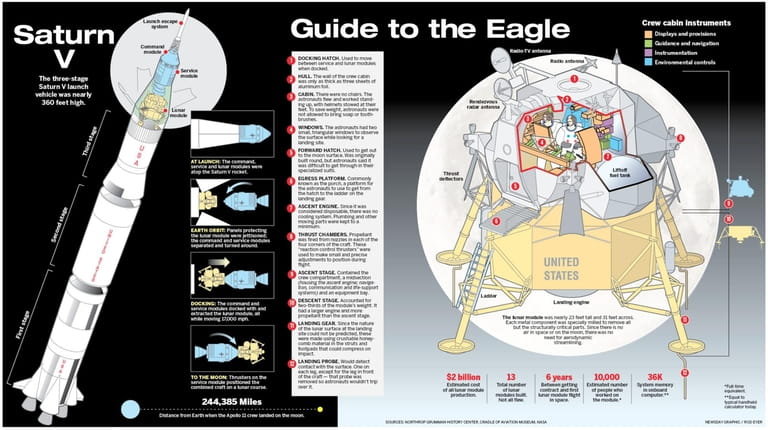Invention of Apollo 11 lunar module considered astounding feat

A view of the front open hatch CDR side in the LM-5 cabin. Credit: Cradle of Aviation Museum, NY
No spacecraft capable of transporting humans has been like the lunar module, which possessed legs and feet instead of wheels, had zero aerodynamic design, and was composed of a structural “skin” so fragile that it could have been punctured with a pen.
On first blush, it looked like a four-legged robot that curious aliens might beam down to Earth. Instead, it was the first vessel to make a landing approach by transmitting beams of microwaves to the lunar surface as curious humans descended on an alien orb.
The inventiveness and engineering underlying the development of the Apollo 11 lunar module — and the vehicles that aided its journey — rank among the astounding feats of American scientific ingenuity, experts today say.
“The design of the lunar module began in the early 1960s, around 1962,” said NASA engineer Stu McClung, of the Johnson Space Center in Houston, who described the lunar module — also called a lander — as the first craft to be solely operated in a distant world.
Developing it required years of research and prototypes, relying on the ingenuity of a battalion of NASA engineers across a range of engineering disciplines — electrical, computer, mechanical and radar engineering. The research also involved cross-pollination with physicists, materials scientists, mathematicians, solar system experts and scientists who understood the complex geology of the moon.
Timothy Glotch, professor of geosciences at Stony Brook University and an expert in lunar geology, said questions about safely landing a spacecraft were answered years ahead of the mission's launch. There was no guesswork involving touchdown.
“Before we landed humans, we had landed robots,” Glotch said, noting that data gleaned from earlier unmanned missions helped NASA experts better understand the composition of the lunar surface.

The lunar module approaches for docking with the earthrise in background during the Apollo 11 mission. Credit: NASA
Fears were voiced among scientists shortly after President John F. Kennedy announced his moonshot vision in 1961. Some thought the dust layer would be so thick a spacecraft would sink. But studies revealed the presence of regolith, the solid surface that pervades much of the moon.
McClung marveled at how scientists more than a half-century ago orchestrated a round trip of nearly 500,000 miles, designing the vehicles — and technology — to make it happen.
An early decision was to invent an ultralightweight spacecraft that wouldn't fly like conventional vehicles, McClung said, but one that could be carried aloft inside a Saturn V rocket, docked to a mother ship — the command module.
Designers decided the most efficient configuration for the lander would be as a two-stage vehicle — descent and ascent stages — that could function as a single unit during touchdown. The descent stage, the lander’s lower section, contained equipment to be used on the moon, as well as the descent rocket engine, landing gear and fuel tank. The upper section contained the crew’s compartment, control panel, oxygen tanks, radar antennae and fuel.

Constructing the lunar module in Plant 5. Credit: Cradle of Aviation Museum, NY
“It was stacked in the rocket,” McClung said of the finished lander, emphasizing it’s important to picture the rocket in its upright position with the cone-shaped tip pointing upward.
The lunar module was tucked away behind the command module, which was at the rocket’s tip and where all three Apollo astronauts rode out of Earth's atmosphere. The rocket’s fuel tanks, loaded with nearly 1 million gallons of liquid hydrogen and liquid oxygen in separate tanks, were below the lander and command modules.
For a voyage 238,900 miles one way, the Saturn V needed 7.5 million pounds of thrust to pierce the Van Allen belts, dense regions of radiation that encircle Earth. A spacecraft as lightweight as the lander would have been vaporized by the charged fields. The rocket muscled the Apollo 11 astronauts out of Earth's atmosphere.
Only the command module and lunar lander journeyed to the moon. Of those units, only the lander descended to the surface. The command module — the mother ship piloted by astronaut Michael Collins — orbited while astronauts Neil Armstrong and Buzz Aldrin explored the dark, airless and dusty world.
“Liftoff was a big moment, but landing on the moon was even bigger,” McClung said, noting the moon lacks an atmosphere so the lightweight lander, composed of aluminum and titanium alloys, could enter the celestial body’s environs without being destroyed.

The lunar module and Saturn V rocket. Credit: Newsday illustration
Touchdown involved computer and radar technology allowing the astronauts and mission specialists back on the home planet to monitor each moment of descent.
The astronauts transmitted beams of microwaves to the moon’s surface during landing, which bounced back to the craft. The onboard computer calculated the delay between transmission and reception of the microwaves to determine the module’s exact proximity to the surface. The closer to touchdown, the faster the microwave reception was registered.
Once their historic exploration was complete, the astronauts blasted off, using fuel in the ascent stage while the descent stage served as a launchpad. They reunited with the mother ship in a daring rendezvous, hovering above the moon. All three rode home in the command module, which had special heat shields protecting it through re-entry into Earth's atmosphere.
“Basically, this was the easiest way to get to the moon and back rather than making one big rocket,” said Joshua Stoff, curator at the Cradle of Aviation Museum in Garden City.
“To this day the lunar module is the only craft that was designed to be used in the vacuum of space. It never went through an atmosphere. That’s why it had an unwieldy hexagonal shape,” Stoff said. “Aerodynamics meant nothing for the lunar module. This was a utilitarian shape — form dictated function. The lunar module had four legs, so it would land solidly.”
Temperature was another consideration in the lander’s design because of extremes on the day and night sides of the moon. While the day side can reach 250 degrees Fahrenheit, the night side can register minus-250 degrees F. Insulation — soft and lightweight — was installed in the lander to maintain an interior temperature of about 65 to 70 degrees F.
A special concern was weight: “It had to be as light as possible,” Stoff said. “The heavier the spacecraft, the more fuel it would burn, which would have given them less hover time.
“The skin of the craft was the thickness of a soda can. It was really flimsy, so flimsy you could jam a pen through it,” Stoff said.
But scientists were aware the moon possesses only one-sixth of Earth’s gravity, which meant the rules of physics differ dramatically between the two celestial bodies. And because of that difference, a flimsy four-legged spacecraft could support two astronauts and their equipment because of the substantially lower gravitational pull.
